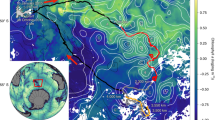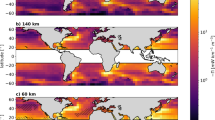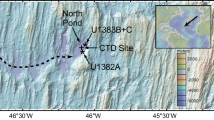Abstract
THE flow of heat through the earth's crust has been measured many times at various continental locations, and is usually found to lie1 within 50 per cent of 1.2 × 10−6 cal. cm.−2 sec.−1. Because of the absence of granitic rocks, with their relatively high radioactivity, in the crust under the oceans, it has been suggested that the heat flow through the deep-sea floor might be considerably smaller; but the only data available from oceanic areas have been two measurements of the thermal gradient in deep-sea sediments reported by Pettersson from the Swedish Albatross expedition2.
This is a preview of subscription content, access via your institution
Access options
Subscribe to this journal
Receive 51 print issues and online access
$199.00 per year
only $3.90 per issue
Buy this article
- Purchase on Springer Link
- Instant access to full article PDF
Prices may be subject to local taxes which are calculated during checkout
Similar content being viewed by others
References
Bullard, E. C., Nature, 156, 35 (1945).
Petterson, H., Nature, 164, 468 (1949).
Jeffreys, H., “The Earth”, 85, 2nd edit. (1924).
Birch, F., J. Geophys. Research, 56, 107 (1951).
Sverdrup, Johnson and Fleming, “The Oceans”, 754 (1946).
Author information
Authors and Affiliations
Rights and permissions
About this article
Cite this article
REVELLE, R., MAXWELL, A. Heat Flow through the Floor of the Eastern North Pacific Ocean. Nature 170, 199–200 (1952). https://doi.org/10.1038/170199a0
Issue Date:
DOI: https://doi.org/10.1038/170199a0
This article is cited by
-
Plate tectonics and Earth’s magnetism: a personal viewpoint
La Rivista del Nuovo Cimento (2021)
-
Improved inversion procedure for obtaining thermal properties of marine sediments via expansion of the temperature decay function
GEM - International Journal on Geomathematics (2021)
-
High resolution temperature measurement technique for measuring marine heat flow
Science China Technological Sciences (2013)
Comments
By submitting a comment you agree to abide by our Terms and Community Guidelines. If you find something abusive or that does not comply with our terms or guidelines please flag it as inappropriate.



